 27th
April 1931 27th
April 1931
 |
I
went onto a hill in Ayrshire to look for a plover's nest. I had seen the hen bird fly off
several times before. This time she flew off again. I hunted about but I couldn't find the
nest, so I went away. I came again and the hen flew off again. I hunted hard and at last
found a tiny platform of hay, and on it four brownish speckled eggs. I took my brother the
next day to see them, but there were no eggs. The mother had removed them to another nest. |
A plover's nest is always
on one side of a hill, never on the top. Then the male bird sits on the other side and
gives warning to the hen.
When we were in Scotland, we found a large
number of nests. There was a Gold Crest's nest suspended on a pine branch within reach.
There was a Long-tailed Tit's nest on an open branch of a Laburnam. Also a pigeon's nest
in the top of a Yew tree and a Tree Creeper's in an outhouse.
9th May
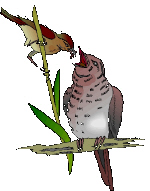 |
I
saw a pair of cuckoos fly overhead. The cock landed on a high wooden bar by a tennis
court, while his mate flew over the tennis court towards a hedge on the other side. I
crept round and frightened the hen out of the hedge as I came along. She flew with her
mate into an oak.
I went and hunted in the hedge for a
suitable nest, and I found a Thrush's nest, too high for me to reach. I went and fetched
another boy - taller than myself. We found the nest was old and empty. However, I came
again by myself, and frightened the hen cuckoo out again. I looked again and found a Hedge
Sparrow's nest, new but empty. |
The next morning I came and
found one blue egg in it. The next day there was another in it. But the next day the
ground had tales to tell. There was one smashed egg on it, and in the nest there were two
Hedge Sparrow's eggs and one cuckoo's. The hen cuckoo had removed the Hedge Sparrow's egg
and placed its own in it.
17th May
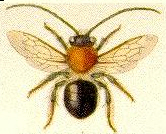 |
I found a kind
of solitary bee sitting on a piece of grass under an Ash tree. It had antennae as long as
itself. (Long-horned Eucera) |
I got a jar of tadpoles and
waterweed from the marshes and took them home. After several days sausages of jelly with
snail's eggs inside and little transparent crustaceans came. After the summer holidays
there were leeches and big snails there.
August 26th 1931
I found a yellow-legged clearwing on a
path under an Elder at Ealing. Real appearance is in May.
Winter 1931
Nasturtiums still in flower in December.
Privet hedges shedding leaves as in
spring, in December.
 Sycamores still in leaf in
December. Sycamores still in leaf in
December.
Herb Roberts coming into leaf as in
spring, in January.
Summer 1931

At Holmwood we used to fish for
Sticklebacks in a pond. The method was this; tie a worm on the end of a string and dangle
it in the water, wait until the stickleback has a firm hold before you raise it. Small
worms should be used, as the Sticklebacks only nibble large ones.
Easter Holidays at Burley, in
the New Forest, 1932
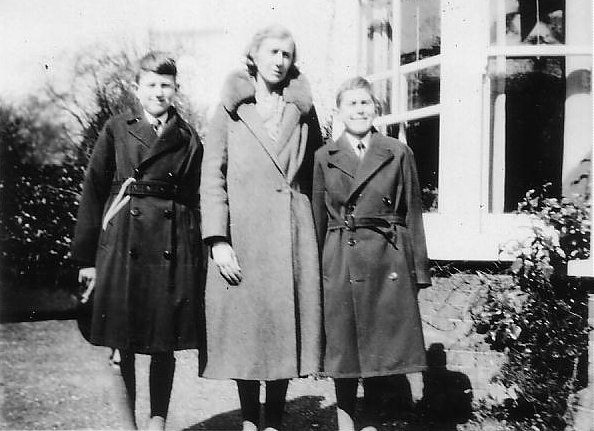
3rd April
(Fairly fine)
We went along the Lyndhurst Road. I found
a nest in a hedge and climbed for it, but an old woman came out and ticked me off for
climbing in her hedge. We went into the forest. I found a Tamarisk Feather moss and some
Wood Spurge, and also other kinds of mosses. There was also some Butcher's Broom, not in
flower.
4th April 1932
(Cloudy)
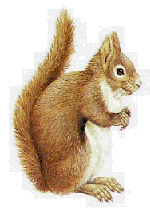 |
We went into the
forest. First we saw a great Tawny Owl. Then I saw what I thought was a dead branch. I
found it to be a Red Squirrel, looking at the grass. When it saw us, it turned round on
the branch and flattened itself out, hoping not to be seen. I also got some mosses. |
In the afternoon, we
wandered about and found a dead tree, from which we poked centipedes and woodlice.
12th April
(Fine)
We went up a hillside by Oakley Enclosure,
but it was too wet outside the enclosure, so we went along the edge inside. When we had
gone a little way, we suddenly saw three Fallow buck about ten yards away. One was about 7
years old, another about five and the other about two. The two oldest had both antlers on,
but the youngest only had short ones, and one had come off. The wind was so that they
couldn't smell us, and John (Tim's brother) shouted when he saw them, so that
they looked round. When they saw us move, they started bounding away fairly slowly. After
a bit they stopped and watched us. But when they saw us running after them, they bounded
on. This happened about three times. Then they stopped and started prancing about, as if
playing. As we got nearer the oldest buck began leading away. Then suddenly about nine
does sprang up out of the dead bracken and went away after the bucks in a great long line.
They were about twelve in all. A bit farther up the path I found a big kind of horsetail.
| We went into the forest and came on a big
Tawny Owl. We came out on the sunny hillside that we found once before. I found a new kind
of Sphagnum moss. |

|
19th April
(Fine)
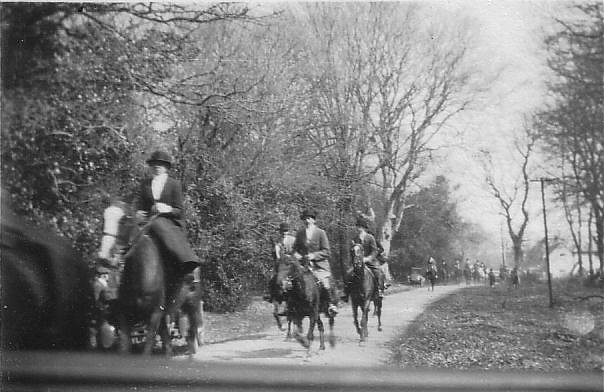
The hunt came past the house. We followed
hard but they were in full cry, so we couldn't keep up. We went about by the streams down
the Lyndhurst Road. We saw the first Swallow flying north fast. Mrs Veile heard a Cuckoo.
24th April
(cloudy)
...After I had gone a little way into the
forest, I saw two trees with no grass under them, and all the earth was chopped up, as if
by hoofs. I thought at once that they were the rubbing posts of a herd of deer. I went and
looked. I saw some quite fresh footprints and I thought deer were not far away. Suddenly a
Hare sprang up from near me, and started rushing away. I went to the next tree, but it
hadn't evidently been used much lately. Suddenly I heard a fairly loud crashing. I looked
up and a buck jumped up and bounded a little way away. I stood like a log. I thought I
could see another deer standing ever so still by a bush. I looked hard and saw that it was
a deer.
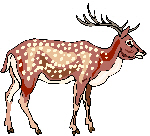 |
He had huge
antlers and a big beard. He stood watching me and twitching his great ears. I made funny
faces at him to make him more curious, but he only twitched his ears the more. At last he
turned round and started walking away. I crept nearer. He turned and looked again, but
went away again. At last he and the other went behind a bush. I looked round and a third
buck and a doe got up and started calmly walking away, without even looking at me. I don't
think they knew I was there. |
At last they all went out
onto the drive and started eating grass. All I could see was their white tails flapping. I
crept away and went home to lunch without disturbing them. All the bucks had beards.
Summer term 1932
I have had several interesting experiments
in Natural History this term.
At the beginning of the term, we caught a
little Field Mouse in the Mongeham Marshes. He was evidently drinking from a dyke.
Suddenly he saw us and ran towards his hole in the roots of a tree. Geary caught him. He
bit us like anything and escaped several times. We kept him in a big tin. He hid under the
grass and ate the bacon rind and bread we gave him.
We used to exercise him on the field. But
one day, while we were cleaning out the tin, he escaped into the modern sixth form room
and ran under the door. He ran downstairs and hid behind the lockers. We drove him from
there and he went out under the deck chairs. From there he went into the cavern by the
lockers. And although he came out three times, Geary, who was expecting that, didn't catch
him and he escaped.
Later on in the term, we saw a House Mouse
by the benches, and although we surrounded him, he escaped into a hole that we hadn't
noticed.
 |
One day someone
found a hedgehog on the field, so we brought it in and gave it some bread, and then let it
go outside the sixth form window. Some days after, I found another in the long grass. We
did the same with him. And when we had put him on the lawn, he ran away at a pretty good
speed for a hedgehog. One of these died soon afterwards, as we found his dead body in the
garden. |
Just before half term Moyle
ma. saw a little white rabbit running about and with Mrs Turner's help he caught it. The
next morning in breakfast we saw another, and again it was caught. They are both from the
same family, I think. And as they are so tame and also as their ears and feet are grey, I
think their mother was a tame rabbit which had escaped and that their father was a wild
rabbit.
Some few weeks after this one of the cats
'Timothy Turner' (now Tabitha) had three kittens. One was a tabby, another a
black-and-white one, and the other a black one. They come out on the lawn every Sunday,
when we are resting, in company with the rabbits. The rabbits are known as 'Swan' and
'Edgar' (Swan is now dead).
| Yesterday in
the match we saw a bat flying about. He flew all over the place and we didn't see him
much. Also last term a bat came into the fifth form. We knocked him down with our
handkerchiefs several times before we caught him. He nipped quite hard. After prayers,
when we let him go, he slid off my hand and flew in circles, low down at first, but then
he went up higher. Also we used to see seven bats flying on the lawn at tea times. I saw
one this term, when I was in bed. |

|
The other day I saw a
Greater Black-backed Gull on the field. He was evidently digesting a meal.
 |
There are a lot
of Swallows on the field. They love windy days when, flying slowly against the wind, they
suddenly turn around and race down with the wind. When they have filled their pouches in
their mouths with flies, they race up and away to their nests, coming back when they have
fed their young. |
There is a pair of
flycatchers which nest in the May tree on the lawn. The young fly onto the lawn in turn
and are fed. They can be seen playing in the May tree. They are very good at dodging after
flies.
Last night, at about ten 'o' clock I heard
a screeching which I knew to be an owl waking. I looked out of the window and an owl flew
towards the gym to hunt. A fat pigeon sat on the lawn last night and I heard the owl
screeching again.
Autumn term 1932
We caught a bat in the fifth form after
prayers, with the result that I was late for extra work. I did not let it go in spite of
Mrs Turner's warnings. Its wing was broken. We kept it in Price's case for a fortnight. It
escaped once. It died of overeating. It used to eat masses of grasshoppers.
April 1st 1933

Last summer I watched a wasp catch a
hover-fly. The hover-fly settled on a privet flower. the wasp, hovering around saw it.It
landed right on top of the hover-fly, which it brought to the ground. First it bit off
both its wings, then all its legs except one, then it bit off the abdomen and flew away
with it.
I have noticed that birds often eat
whites, which I thought didn't taste nice to birds.
It does not affect a butterfly or moth if
all its scales are rubbed off. It can still also fly with only three wings.
Blackbird (Turdus merula merula)
The Blackbird builds its nest of straw and
moss, lined with mud, almost anywhere. It is usually in a hedge, not hard to get at, but
at times it builds on the ground. I once found one under the roots of a tree, exposed by
the rain washing the earth away from them. The eggs are of a dirty white ground colour,
dotted with brownish-green speckles. They are greatly varied in shape, some being almost
round, others being quite oblong. Blackbirds are frequently found with white feathers on
them. There has been one for three years at Burley, in the New Forest. It has a white head
and breast and some white tail feathers. The male Blackbird's colour is glossy black with
a yellow beak. The female's colour is brown with not quite such a yellow beak. The
Blackbird's alarm cry is chuck-chuck-chuck-chuck-chuck.
|
